#like the envelope and lfo and stuff
Explore tagged Tumblr posts
Text
just spent like 450 bucks on a modular video processing unit 🤣
#itll be worth it for sure but damn#like the effects arent anything particularly special but it has a ton of I/O#including cv gate control which is nice cause we can use my friends semimodular synth#like the envelope and lfo and stuff
3 notes
·
View notes
Text
We've got a musical instrument shop only a few blocks away. They're more focused on band and orchestral instruments than on the sort of stuff that I mess with, but I like to poke in on occasion to pick up guitar picks or ukulele strings, or just to see if they've got any interesting guitar pedals.
Today, though, they had an Arturia MicroFreak on display: a hybrid synthesizer with a multimode digital oscillator and an analog filter, a really cool modulation matrix where nearly every parameter can be driven by the LFOs or envelopes, a microphone input and vocoder, and a touch keyboard with CV/Gate/pressure outputs that can drive Eurorack gear. I've wanted one since they launched in 2019, but I've never had a chance to actually play with one, so I fiddled with it for a while — some great sounds in there! — before looking at other things. Ultimately I don't have the funds to buy it. Although the store does have some kind of monthly payment setup...
2 notes
·
View notes
Text


been doing normal (thru the imput jack) sampling on the roland s-330 for a while so i thought it was time to play with some of the pc tools people made for the first gen roland s-series samplers. this time i used pctos550 [ https://tinyloops.com/doc/roland_s330/software.html ] to send samples to the s-330 thru sysex and its really nifty. after increasing the default delay time i was able to send samples over without them ending early
these test samples are snes kirby instruments from spc files rendered with c700 with all the envelopes removed and then downsampled to 30khz and snipped down to 12288 samples (the max samples in a 0.4 sec roland segment) in wavosaur. doing it like this lets me remake the amply envelopes and pitch lfos in the roland itself. i picked these specific kirby samples cuz theyre some of the ones i cant source from hardware that i currently own (except for feedbackwave i just did that one cuz i love feedbackwave)
shit is v cool. ill stick with sampling most stuff thru the rolands input port so that the converter can color the sounds a lil but this perfect byte sysex method will be v useful for something i havent tried yet: utilizing the V-Mix key mode patch parameter and 2 outputs to make a patch of a proper stereo sample. the manual mentioned trying this so now im curious
1 note
·
View note
Text
Moronavirus!
Just to be totally up front and honest with y’all, I gotta let you know that personally, I’m rooting for the coronavirus at this point. As a pal posted on Facebutt: “China virus will not kill anywhere near enough people to raise the average IQ of the planet.” I have to say I agree. Best of luck to you and yours, on with the synthing!
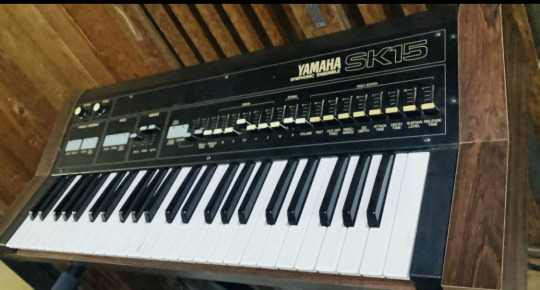
Impulse buy that I pretty much immediately regretted. I have a soft spot for string machines. I had a Korg Lambda a few years back. Probably shouldn’t have sold it. But I did. Saw the SK-15 for $100 on the auction and thought yeah why not? Not the worst sound by far, but given I’ll hardly use the organ section, and the synth section is almost as bare-bones as you can get, well, yeah it’s already sold. Seriously I think I had it a grand total of two and a half weeks if that. It’s in great shape cosmetically, and came with the flight case, but some of the buttons were stubborn so I thought I’d desolder them, disassemble and repair whatever needed repairing. Here’s what one of the ginormous button assemblies looks like:
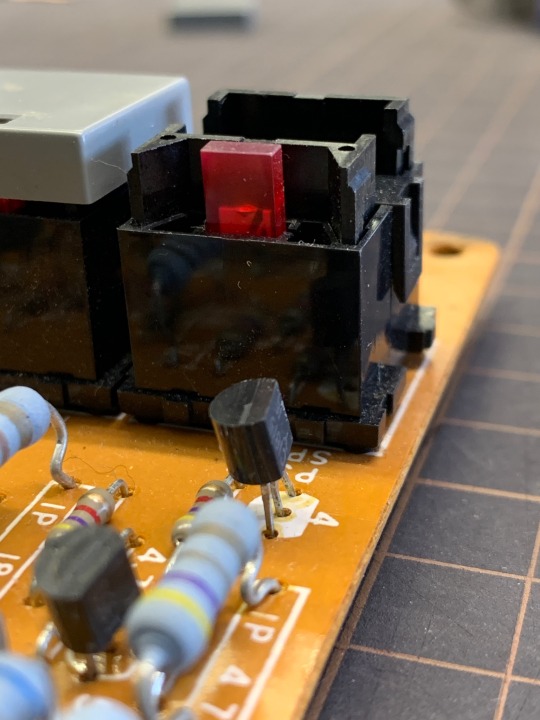
Popped the business end off. And here’s one desoldered and discombobulated:
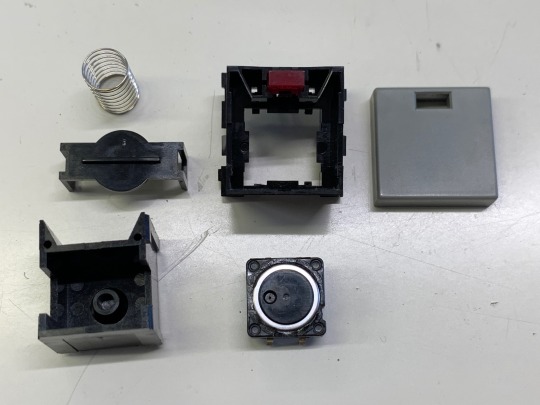
Standard tact switch right there bottom row, center. It was a quick job to swap the old ones out, but anyone out there wanting to do this needs to be sure to replace the switches with ALPS SKHCBFA010 as opposed to the better, sealed Omron switches because of this:
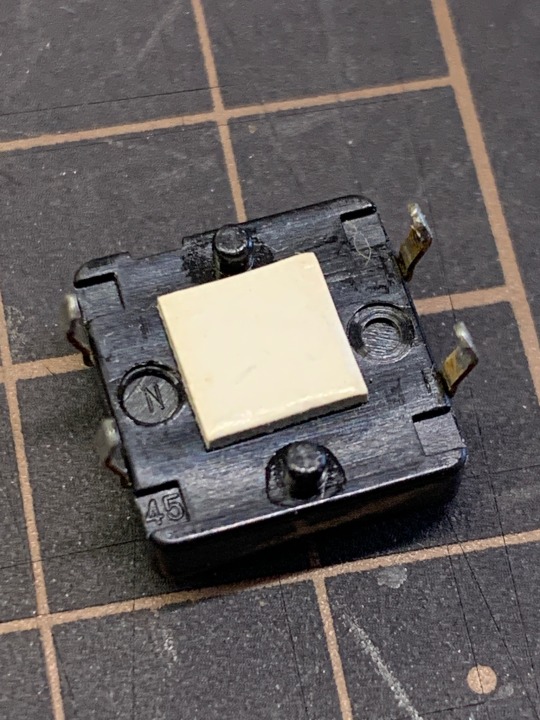
Look carefully and closely at the corners. At lower left you can see a 45 there yeah? Those indentations are what wee clips on the underside of the big button housing snap into. Omron tact switches don’t have those. Also, that white cardboard square plastered on serves a purpose, it ensures that the switch stays a certain height off the PCB. So you’ll need to carefully pry those off and stick ‘em on the replacement switches (double sided tape did the trick). After they were all done, two were still acting up. As far as I could tell, it was due to the way the LED sorta snaps into place, almost like the snap gets in the way and doesn’t let the moving part of the switch housing to return to its original position. If I had more time (and ambition) I would’ve probably given the inner part a light sanding on the sides that contact the outer housing, and that may have opened up just enough leeway for the switch to move more freely. But I didn’t. I did replace the dirty felt-like strips that surround the sliders, and where the hinged front panel rests on the keys, and that looks nice. Kind of a lot of elbow grease and TLC for something that spent so little time here. I do like to see things off in better shape than when I got them though.
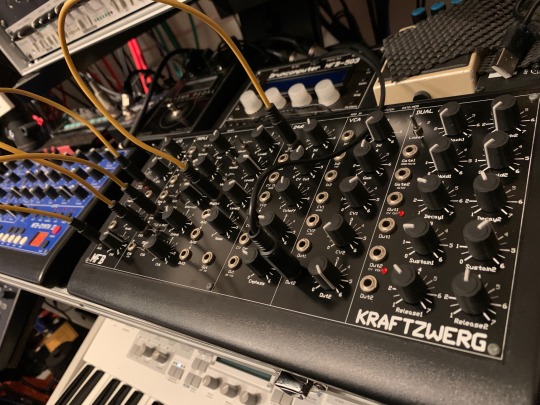
It’s MFB Mofuggin’ Mania!! Feast your bezoomny grahzny glazzies on that horrorshow chellovek, O droogs. KRAFTZWERG!!! The Power Dwarf!!! Basically it’s the guttiwuts of the Synth 2 (which you can see there too), but with no memory, no sequencer, no “keyboard,” instead you get patch points. This thing sounds fat as fuck. Patching stuff on the KRAFTZWERG is like if you fed the Synth 2 a big batch of LSD. Madness!! I’m seriously thinking of selling the Polivoks now. Yes, it’s THAT good. The Polivoks filter is a whole different kind of insanity, but otherwise it’s a pretty sterile but very good sounding synth (only one LFO, no PWM, no bender or mod wheel) though the looping envelope bit is very appealing. Hmmmmm. Anyway, KRAFTZWERG!!!!!!!
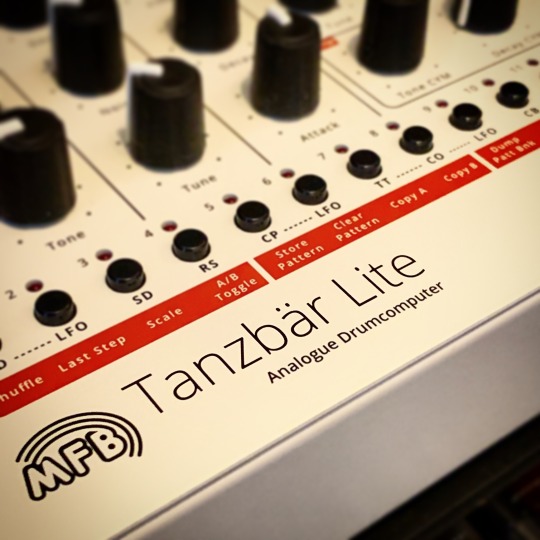
And the latest in the MFB bunch is the Tänzbar Lite. Basically an MFB-522 with (drum roll please) maybe a few more sounds, less noise, a set of LFOs, and PARAMETER LOCKS!!! Yeah I totally wasn’t expecting that. I have an MFB-503 and that one saves the sound settings per pattern, which is a fantastic feature, but the Tänzbar Lite takes it a step further with parameter locks. The big drawback with it is the learning curve, and havibg to get used to some very counter-intuitive button press combos (you have to hold shift+play to start and stop the onboard sequencer....why it’s like this is anybody’s guess). Anyhow I’ve been using a Drumbrute Impact for a little while now, and while I LOVE the sequencer and I do like the general sound, I find the bass drum a bit flabby when the decay is cranked, and the snare almost totally lacks any punch at all (remedied with individual output and processing but that requires extra braincells, cables, and devices, and I just wanna get shit done already). And of course, no parameter locks, and no saving of sound settings per pattern (or at all really, it’s in perpetual “Manual” mode). So yeah, see ya later Drumbrute Impact. MFB for me. I’ve got one more special guest showing up this weekend, so keep a lookout for a new post soon. Until then, be well, but don’t be afraid to die. Worse things can happen.
#fucktrump#satan#diy synth repair#aaaargh#mfb tanzbar lite#yamaha sk15#mfb kraftzwerg#madness#gogocoronavirus
2 notes
·
View notes
Audio
Pseudo-arpeggios! Using a Bloom on 1x and Marbles on 3x clock through a precision adder then a quantizer to effectively arpeggiate the sequence. Bloom is allowed to roam across its variations, but Deja Vu on Marbles is locked so it’s relatively consistent. There’s still a /8 LFO on bias to keep some variation in the arpeggiation.
That’s the interest stuff going on! Sound path is Ts-L’s triangle and wavefold out mixed, through Strega with Strega’s tones modulated by the same LFO as Marbles. A vector envelope with a peak in the middle third goes into Strega’s attenuated time input, accenting the middle note of each arpeggio. Strega also has modulation from the Agitation generator pseudo-sidechaining/wahing the final output level via another VCA. Finally, the mix goes through Data Bender and Melotus Versio for space and atmosphere.
The patch is played by slowly tweaking the branch and path parameters to predictably play through iterations of the trunk sequence. It almost feels like a real song! Almost. We’re getting there, though! I really like the climax created by decreasing the length of the Marbles loop towards the end to play with the rhythm of the piece.
#electronic music#modular#modular synth#modular synthesis#synthesizer#synths#audio#eurorack#generative music#lo-fi music#lo-fi#noise#noise music
0 notes
Text
Free vst plugins for fl studio

Rapid also has an intuitive UI, and is easy to pick up and use. The possibilities with this synth are almost endless, and it’s a pure sound design beast. Modulation is vast too, including 4 LFOs, 4 Envelopes, 4 Sequencers & up to 32 routing options. You can also choose from a number of presets, and have extremely precise control over it. It can read MIDI, meaning you can import anything from your 3rd party packs, or whatever you have inside your DAW. You also get access to 22 different FX units, as well as an extremely cool arp. The quality of these samples and wavetables are second to none, and honestly… I’m a huge Omnisphere lover, but I fully believe this is a cheaper version, with a lower CPU hit. With Rapid, they also include a huge library of factory content, which has over 250 unique wavetables to choose from, and a huge library of 600+ multi-samples, including stuff like: guitar sounds, warping granular sounds, entire drum kits, and a tonne more!

The type of sound that continuously evolves and never becomes boring.

This means you get 8 instances of 3 oscillators, samplers, the effects included, and things like LFOs, Envelopes, Sequencers, Arps etc.Īnd, as you can guess, you can make some incredibly in-depth sounds with Rapid Synth. With Rapid Synth you get 3 oscillators, and 8 total layers that you can blend together. If you want to find out more about Rapid Synth, check our full, in-depth Rapid Synth review. Parawave’s Rapid Synth is the best value for money power synth we’ve used, and it competes with the likes of Omnisphere and UVI Falcon. (it’s also 0% interest) Spectrasonics Omnisphere 2.6 Not only are you able to pay in instalments of as little as $9.99, but each payment gets you closer to owning the virtual instrument! One of the best things about Serum is the rent to own options. You can import any audio into serum and turn it into a wave-table, to create completely new and unique sounds. What some of you might not know however, are the sampling capabilities of Serum. It’s very friendly to beginners and sounds great. Unlike a lot of modern synth VSTs, Serum has remained comparatively simple. The audio quality is top-notch and the control + freedom you get, while working with Serum is a breath of fresh air. Like we said in our Xfer Serum VST review, Serum is extremely easy to use, while remaining unique and interesting throughout. Well, it is undoubtedly one of the best and most beloved plugins for the modern producer. You know, that wave-table synth that everyone seems to be using. If you’ve been producing for more than a week, I’m pretty sure you’ve heard of Serum. Sacrifice your CPU to the Divine Gods Serum But, it does have a multicore mode for those that aren’t using their Mum’s old Packard Bell from 2004, which helps reduce the hit. Using this technology does make Diva extremely taxing on the CPU, meaning you’ll have to sacrifice your processor to the gods to power the divine beast. This makes it sound incredible & also gives it zero-delay feedback response on filters – making it the most true emulation of analog gear we’ve ever seen. It uses special PSpice technology to model analog circuitry at component level. That means you can have a MiniMoog (Triple VCO) oscillator, with a Jupiter 8 filter (cascade) & a Alpha Juno-2 envelope, giving you the most phenomenal crossover of warm, analog sounding gear.ĭiva also sounds excessively similar to the original hardware, & you’d be hard pressed to find someone that would be able to tell the difference. What’s even cooler, is that Diva has slight modular capability – allowing you to mix and match the oscillators, filters & envelopes to your liking. It’s a virtual analogue synth that impersonates over 5 decades of analog hardware synths, including: (btw… if you want a more in-depth overview of what Diva can do, then be sure to check out our uhe Diva review)
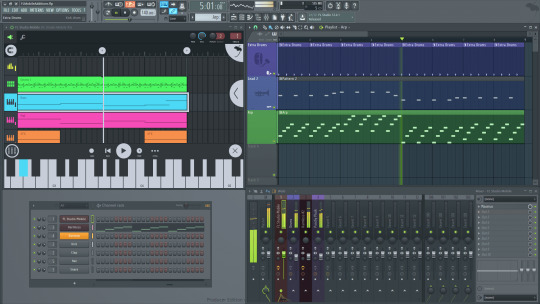
Uhe’s Diva made top of this list because of the sheer quality of sound it produces – it’s simply the best sounding synthesiser that money can buy. The great thing about digital synth vst plugins is that, they don’t have limits to their capability.īelow are our picks for the best vst synths of 2021. Let’s face it, there’s not much more satisfying than a great software synthesizer.Īnd with the advances in plug-in technology, software synths have become a welcome evolution for synthesis & the music industry.
What Are The Best VST Plugins For Beginners?.

1 note
·
View note
Text
Syntorial skip

Syntorial skip full#
Syntorial skip plus#
The influential sound machine has been used by the likes of Stevie Wonder, Herbie Hancock, Dr. Over the following decades, music technologies would explore the artistic applications of the vocoder, whose robotic vocal articulations would soon find their way into mainstream music, television, films, and games. During WWII, the US military used this advancement to electronically encode classified audio messages that could be reconstituted on the receiving end. In the 1930s, Bell Labs introduced the technology as a telecommunications device that could deconstruct the most fundamental elements of human speech and then reconstruct a new electronically synthesized voice. "The history of the vocoder is as unique as the sound it produces. The Moog 16 Channel Vocoder’s analog voice circuits, derived from the original schematic, are hand-soldered at the Moog Factory in Asheville, North Carolina to preserve the original instrument’s classic sound." Originally introduced in 1978 (and heard most famously on the title track of Giorgio Moroder’s E=MC2), the instrument has been used to transmute vocals, transform synthesizers, and electronically encode sound for decades. Allowing CV control of the Drag parameter, the Afterneath can be played melodically and constrained to different scales and pitch classes based on the selected Mode, allowing sequenced reverbs that form a counterpoint against the sounds that feed them.Ī powerful new tool for sonic exploration of the unreal, the Afterneath module marks an exciting step of one of the most interesting pedal manufacturers into the world of modular synths.Īfter more than 40 years, the Moog 16 Channel Vocoder is officially back in production. Diffused echoes bounce off distant walls, and sonic ghosts emerge from soft, washy reflections and short, chattering delays. Expanding on the original Afterneath design with additional reverb modes and the addition of CV control, Afterneath Eurorack is a great way to add some space to any Eurorack system.Īfterneath excels at reverbs that evoke a sense of unrealistically huge, empty spaces. "Afterneath is Earthquaker's first foray into producing Eurorack modules, adapting their cult classic reverb pedal into a washy, shimmering tool for modular synthesists. There really is simply too many features to list and explore here." You can get stuff out of this that you simply can't get anywhere else (or without spending huge sums of money on rare individual Blue Lantern modules). Given the ton of patchpoints and built-in modulation paths, this is a tweakers dream synth. Filter FM is there, the envelopes are loopable, and the delay parameters have cv inputs to modulate them in real time. Yes - you can have more than one selected (or all 3) at a given time.įrequency Modulation (FM) of the oscillators is possible (linear or exponential). The filter - LP, BP, and HP individually selectable. There's also Noise - with a Tune knob to adjust the kind of noise being generated. All 6 outputs have individual level controls in the mixer and a waveform selection switch.
Syntorial skip plus#
The oscillators have 2 separate waveform outputs plus a Sub-oscillator. Two oscillators, filter, 2 envelopes, 2 LFO, delay.īut that's not the whole story. Pulse Width: Go back and keep tweaking the Pulse Width until the tone sounds right.You cand find some demos of the Dwarf Star in previous posts here. Reverb: Small-medium Size, and cut out most of the Reverb’s highs so it’s just a nice warm round ambience.
Syntorial skip full#
Enough Modulation amount to create a nice bright attack transient.Īmp Envelope: Same settings as Filter Envelope but make the Decay and Release a bit longer, around 170 ms so you can hear the Filter Envelope’s full shape. And then bring the Cutoff down to around Noon, which will then be modulated by…įilter Envelope: 0 Sustain, quick Decay and Release around 110 ms. And then bring down the higher oscillator a little bit.įilter: 24 dB Lowpass. And then pan one a fair amount left, and the other a fair amount right to get that width. Both set to Pulse Waves, with a Pulse Width pretty close to square, but not quite all the way square. Oscillator: Two oscillators, one octave apart. I tinkered around with this one (awesome track by the way). The FM/sync tone may just be two Pulse Waves set at just the right width.

0 notes
Text
Its sort of cool. I’m at the point where I pretty much intuitively understand the MS-20 patch bay and what everything does. Which means I have to watch the tutorials all over again because I have no idea what any of this stuff does.
Really, what I finally get are the envelopes. Which is big, I think. It really helps watching these modular synth videos and thinking... fuck, I don’t wanna buy that, how do I fake it? I was looking at this Envelope Generator and one of the settings was “cycle envelope”, as in loop it. And it was like, oh, no shit, of course. See, my first real synth was the Nord Lead 2, and it had cool LFO’s to fuck with and my brain had just not quite pieced it together that that’s what I was missing. (You might ask, then what the fuck have you been doing all this time? I don’t know. ¯\_(ツ)_/¯ It just didn’t occur to me.)
Anyways, my stack-cables came in the mail.
Also, I should figure out how to make a random clock generator, but that seems easy to me. You just use the external processor to mis-interpret randomly audible notes as triggers. That’s one way to do it anyway.
2 notes
·
View notes
Text
The Best 8 Free VST Instruments You Must Have in 2020


. In this blog, you'll find the top 8 free VST instrument plugins available online that you won't want to miss out on! While you have to create an account for some of these instruments, you can download others directly and we've included the links with each plugin featured below. A few of them also require additional software in the form of some kind of product management software but don't worry we know you'll be able to figure it out because these are all must-haves and it'll be nothing that a quick Google search can't fix! These are the best free VST instruments for creating professional music without spending a fortune on expensive software... .
8 Free VST Instruments You Must Have in 2020:
DSK Instruments . The DSK Music site is run by a guy called Victor, from Spain and his freeware VST instruments are some of the best you can find around for free. There are a lot of free VST instruments on his site, dskmusic.com, and just because they're free it doesn't mean they're poor quality, in fact, you'll find it's quite the opposite! . You can find some great high-quality multi-sampled instruments there on the website. You can download a lot of free stuff at dskmusic.com: SynthsRomplersDrumsSamplers . The video below shows you some examples of what you can do with these DSK free VST instruments, and you'll see you've simply got to have them so be sure to check it out...just click here to be taken through to the DSK site where you will be able to download whichever free VST instruments take your fancy! . https://www.youtube.com/watch?v=pQewvfTmHqI Video Source: DSK Music: Free VST Plugins by PSJ . GTG 44 . The GT44 is a free analogue VST plug-in and it basically has all you need for a good music production piece. It's an old-school analog-sounding plugin and is the ideal instrument. Features include six voices, a sub, a filter envelope, a filter pitch envelope, and it also has a chorus plus much more! You can preview it here in the video below or just click this link here to head straight over to the download page to get it for FREE today: . https://youtu.be/zLloFnNrbP8 Video Source: 44 S || Free VST Plugin || Analog Synth by Free VST Plugins . Tal-Noisemaker . The TAL-NoiseMaker is another favourite free VST instrument you should have in your arsenal. This version is an improved reworking of the TAL-Elek7ro and has a completely new synth engine and a lot of improvements in sound and usability - It's basically another intuitive all-round synthesizer with a very good sound. It's easy to use modulation unit has some great modulation effects. A ring modulator and a syncable triangle are also included as part of this synth. There is also includes a small effect section included with this synth with a reverb, chorus and a simple bit crusher effect. Check out the demo below or head straight to Tal Software to download it now: . https://www.youtube.com/watch?v=a5l-31rc8kM Click here to be taken to the website to download the TAL-NoiseMaker . Dexed . This Dexed instrumental plugin is a multi-platform, multi-format plugin synth. It's closely modeled on the Jam AHA DX7 - the first successful digital synthesizer manufactured by the Yamaha Corporation from 1983 to 1989. It was and still is to this day one of the bestselling synthesizers in history, so you've most probably heard a song created using the Yamaha DX7. You can check out how it sounds in this video here: https://www.youtube.com/watch?v=wSs1-020nNY&feature=youtu.be . If you liked what you heard, click here to download the Dexed FM plugin today! . 4Front Piano . The 4Front Piano VST is a useful plug-in for musicians who are in need of a lightweight, low-CPU upright-style, acoustic piano sound. This instrument is small on memory and the CPU usage was found to be useful by many users and software developers as a plug & play piano module, which does not require any configuration or adjustment. If you're trying to get a free VST piano that doesn't sound like the stock piano then this one's for you... . Click here for the link to the download website and if you want to give it a listen to first, you can hear it's sound here in this video below: . https://youtu.be/wi_zySsnPXI . T-Force Alpha Plus . The T-Force Alpha Plus by Mastrcode Music is the advanced version of the T-Force Alpha TS and is a really intuitive free VST instrument. It has all the features of the Alpha TS with some updated functions. It's easy to make uplifting trance sounds with it and you can also do a lot more, you just have to get creative! Check the video for sound examples: . https://www.youtube.com/watch?v=Z1C64Ky5rso . You can find out more information including specs on the download page here: https://www.kvraudio.com/product/t-force-alpha-plus-by-mastrcode-music . U-he Tyrell Nexus 6 . The Tyrell Nexus 6 is a free Analog / subtractive synth plug-in developed by u-he. It is a great sounding synth backed by the u-he sound engine and possesses an intuitive interface. This synth is a must-have if you love creating sounds like those possible with the Juno series from Roland. Its features are what we might expect from a vintage synthesizer like the classic Roland Juno, such as: Smooth overdrive in the oscillator mixer.Filter output can be fed back into the mixer.Unison mode, with voice index modulation source.Envelopes can be looped or triggered via LFO.Envelopes retrigger just like classic hardware. . Check out this demo video below and click here to download this free VST instrument from the website: . https://youtu.be/1aSTko-BYeE . Helm . Helm is a free, cross-platform, polyphonic synthesizer with lots of modulation and it was developed by a guy called Matt Tytel. It runs on GNU/Linux, Mac, and Windows as a standalone program and as a VST/AU plugin. Features include: 32 voice polyphony, a powerful modulation system with live visual feedback, dual oscillators with cross-modulation and up to 15 oscillators each, unison and harmony mode for oscillators, oscillator feedback and saturation for waveshaping, 12 different waveforms, 7 filter types with keytracking, 2 monophonic and 1 polyphonic LFO, a step sequencer, a simple arpeggiator and lots of modulation sources including polyphonic aftertouch. You can hear every preset featured in Helm in this video below: . https://youtu.be/vN7zsJ-eIpY . Go ahead, get downloading today and test it out for yourself, by clicking here the download should happen automatically . It's hard to imagine that so many quality tools are available for you to use at no cost but free VST instrument plugins are one of the most exciting things about mixing and we hope that you'll enjoy all of the free VST instruments included in this blog and that they will help you on your music production journey towards making great music! . At Indiy, we believe artists should have complete ownership of their content. . We are an online marketplace for musicians, the place to buy and sell your music services, check us out by visiting our home page, or just click here to be taken straight to it...if you have something to offer be sure to sign up or search for whatever it is you need for your music today! . Good Luck on your music journey ✌️ Read the full article
0 notes
Text
August 09, 2020 at 10:02PM - BEAT ZAMPLER Workstation Plus 3 Studio Pack (100% discount) Ashraf
BEAT ZAMPLER Workstation Plus 3 Studio Pack (100% discount) Hurry Offer Only Last For HoursSometime. Don't ever forget to share this post on Your Social media to be the first to tell your firends. This is not a fake stuff its real.
Audio Workstation for VST&AU + 4 GB Soundbanks
BEAT ZAMPLER is a workstation that includes a variety of ways to sculpt and manipulate sounds and it includes features you would expect in any current soft-sampler. It also sounds great!
Features
The plug-in comes in both VST and AU formats. File types supported are REX loop and SFZ.
The plugin’s sample oscillators make Zampler a great tone-shaping tool
In the integrated multimode, lowpass, highpass, bandpass and bandstop filters, as well as various combinations are available
Three LFOs, three ADSR envelopes and a complex modulation matrix, bring life to the sound.
An extensive effects section is available including tube saturation, two equalizers, phaser, chorus, delay and reverb.
The clever step sequencer allows for especially complex, full and vibrant sounds – a speciality of Zampler.
Uses the valent algorithms of “Dune” inventor Synapse Audio
More Details:
Samples of any bit-depth (8/16/24/32-bit), mono or stereo are supported
Multiple sample rates supported (eg 44.1k, 48k, 88.2k, 96k, 176.4k, 192k, 384k)
Up to 128 keyboard splits
Up to 128 velocity splits
Soundbanks on Top
Ethnic Pads: 32 patches
This collection excels in atmospheric sounds in a broader sense, comprising bells, choirs, cymbals, flutes, chimes or strings and much more. We pushed the sounds to their limit and injected a heavy dose of electro to give the sounds enough bite to cut through modern EDM productions. With our Zampler workstation featuring flexible filter and modulation options, you can easily create unexpected sound textures from the sample material.
ROBO#tTXTR – vocal Soundbank. 34 patches + 40 loops
Robo #txtr“ is an extensive collection with 1.5 GB of electronic vocals, phrases, machine and robot noises. Expect production-ready presets, just waiting to be manipulated with its flexible sound editing and automation tools.
SUPREME EDM The best analogue synthesizers – 32 patches + 32 loops
Modesty is not this packs’ strength – „Supreme“ combines sounds of the best analog synthesizers of all time. With 32 brutal patches and 32 loops you are perfectly prepared for future Dubstep, D&B and EDM adventures. The editorial staff of Beat presents 620 MB of its favorite bass and lead sounds, which give your tracks a special touch and a high recognition value.
Brute Factor: 760 MB Leads & Bonus-Tracks
Analog sound is always wanted. And it’s even more wanted when it sounds fat or brute. Just like the Arturia MiniBrute 2. As the synth was already honored with full marks, we just made a studio session and dressed it up for our very own Zampler, so you can now enjoy the savage sounds yourself. And we included a bonus, something that the MiniBrute hardware can’t do: Pads. Happy blasting!
MANTRA PADS – 33 relaxing patches – 1,6 GB Power
The power of repetition! With their lush character most pads have an instant relaxing impact. Our latest Zampler sound bank takes this a step further and combines pleasing pads with ever-repeating mantras, to maximize the hypnosis-factor. 33 patches of pure deceleration.
PROPHET-12: 78 patches 2 GB analogue masterpieces
So many famous artists using the Prophet-12 can’t be wrong: Dave Smith’s luxury synth is a true multi-talent when it comes to sound design. From underground clubs to airplay charts, its fat basses, leads and pads fit everywhere. So here you go with your own Pro-12 for Zampler//RX!
TORAIZ AS-1 – 64 patches + 64 loops: 734 MB Beat, Leads, Pads & loops
Thanks to his Prophet-6 core, the new Toraiz AS-1 is born to be an iconic legend. We created 128 patches and sequences of that little muscleman, ready to play for your Zampler. Enjoy!
from Active Sales – SharewareOnSale https://ift.tt/392928U https://ift.tt/2CDdU8h via Blogger https://ift.tt/2DtdKBm #blogger #bloggingtips #bloggerlife #bloggersgetsocial #ontheblog #writersofinstagram #writingprompt #instapoetry #writerscommunity #writersofig #writersblock #writerlife #writtenword #instawriters #spilledink #wordgasm #creativewriting #poetsofinstagram #blackoutpoetry #poetsofig
0 notes
Text
Part of my stimulus check went for a new synthesizer, and I'm newly realizing the reports of getting bombarded with ads for the thing you just bought are not exaggerated. It's probably largely due to the fact that I looked the thing up on easily a dozen music and electronic shop sites and did repeated Google searches in the leadup, but it's still bemusing.
The synth is one from a few years ago, the Arturia Minibrute 2S. It's a semi-modular analog monosynth with two oscillators, a Steiner-Parker multimode filter, both ADSR and AR envelope generators, two LFOs, VCAs and line-level and headphone outs, and a 48-point patchbay — 28 in, 20 out — both for modifying the internal processing and for hooking to other synthesizer modules (especially Eurorack). Instead of a piano keyboard, it has sixteen pads which can be played or which can control the three-track, 64-step sequencer.
That's all a bit word salad if you're not steeped in this stuff, so here's a video that reviews the device and shows what it looks and sounds like.
I've for years been plotting out my own modular synthesis setup, and have even managed to build a couple simple modules. But I've long had something of a bootstrap problem. One of the modules I've designed and want to build and use is a multiple attenuverter, which would let you take a signal, plug it into this module, and you suddenly have multiple copies of the signal, and each one you can attenuate (like turning down a volume knob) or Invert (flip the waveform upside down). This can be useful in a number of processes, but if you don't have a signal to plug in to it — or further stuff for the modified signals to work on — it's just not very useful solo.
So for a while, I've been wanting two things — 1) a Eurorack-compatible semi-modular system, to be a basic voice and thing to act and be acted upon, and 2) a device that takes notes from a MIDI controller or computer, or generates notes itself via buttons or pads or by playing a sequence, and outputs the control voltages that modules need to do anything. With the Minibrute 2S, I get both.
I'll still be building my little modules, but it'll be nice to have some framework, y'know?
I'll try to post some audio or video once I get the machine; it's currently in transit. I decided to buy from Perfect Circuit, an independent synth shop in LA, for three reasons. First, I wanted to help smaller businesses than huge conglomerates. Second, they had one on stock, which not everyone did. And third, they had a 10% discount offer.
Super excited for Monday's scheduled delivery!
0 notes
Text
Alisa 1387, Part I
Well, my invisible droogies, it was Xmas in March, me brothers. You see, my Belarusian pal Egor, out of the bloody sincere kindness of his heart, shipped me a goddam Alisa 1387. FOR FREE! I offered to at least pay for shipping (no idea how I’d have done that though, as PayPal doesn’t seem to allow sending money to Belarus last time I checked, maybe it’s different now) but nope. I mean WHO DOES THIS KINDA STUFF?! In this day and age of Drumpf and Breggzit and Me First, Fuck You! Duuuude. Egor, I really appreciate it!!!!!!!

Not in the best (or worst) shape. But the lass is in need of some serious refurbishment. As you can see in the photo above, a number of switches were broken and missing their buttons. But Egor sent me a box of extra knobs, buttons and switches!!!! Goddam man! I owe you, for real. Anyway, I had no idea where I was even gonna start, because before he sent it he provided me a long list of ailments the poor thing is suffering from: “Keyboard is really buggy to not working so I couldn’t get envelopes to work, osc1 is working but something wrong with triangle additional wave shaping, PWM works. Osc2 sounds too low so I think there something with capacitors there. On output only pulse, so need to check triangle waveshaper also. LFO works. Filter works but pots everywhere are almost dead, they need careful cleaning and resoldering. So a great amount of work is needed with it not only soldering but also work with hardware refurbish. Do you still need it?” Bwaahahahahahaha!! I said “yeah!” And so, here we are. First thing I decided to unfuck was this:

WHY DO PEOPLE DO THIS?!?! I had the same deal on a DW-8000 I just flipped here a month or two ago. But that’s not it, ohhhhh no, it was even scarier on the inside!!!!

The wires were being held together with scotch tape!!!?? Fucking Holy Electrocution By A Russian Synth, Batman! I wanna just yank the socket and put a standard jobby in but the frame is damn near 2mm thick, and it’s fucking STEEL, so cutting/filing is Not Going To Be An Easy Job, so I’m still on the fence as to how to remedy the Power Cable Connector Conundrum.
Next job was replacing all the electrolytic capacitors. Not a super hard job, but I started noticing that the values of components on the schematics and those in the actual synth in front of me did not match. That, and what looked like a polarized electrolytic on the schemo was in fact a Gifuckingnormous mylar or in some cases poly cap. What?! Jeez. And then I found this:

Milk carton time. Have You Seen Me? MISSING CAPACITOR! I was like, you have gotta be shitting me. And the fucker wasn’t rattling around loose inside the synth either!? And there are vacant areas on the Generator 1 (VCO1) daughterboard where the schematic shows capacitors should be. What, they run out at the factory and just decide “fugg eet, no capahceetorz for you, comrade synth!” or what? And that ain’t all the shenanigans going on with that board either! Get a load of this!
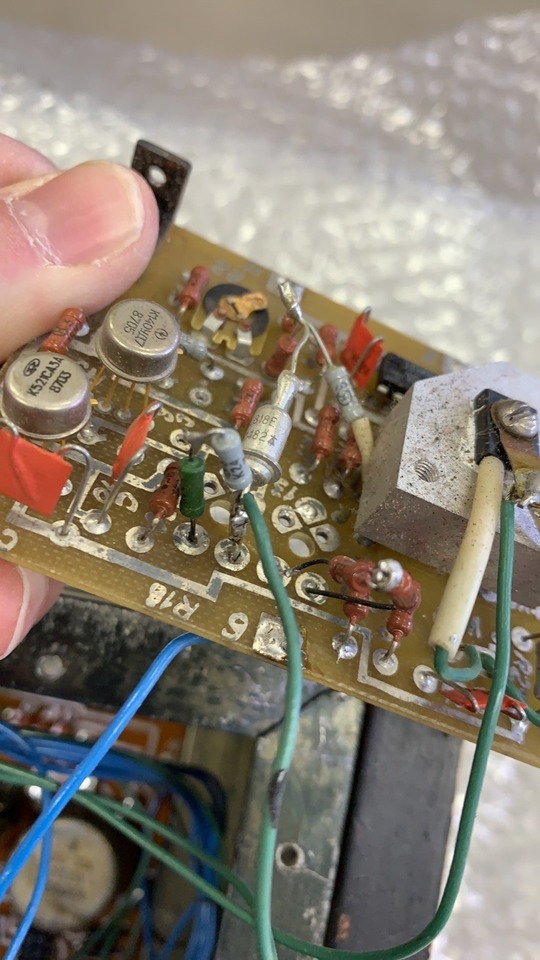
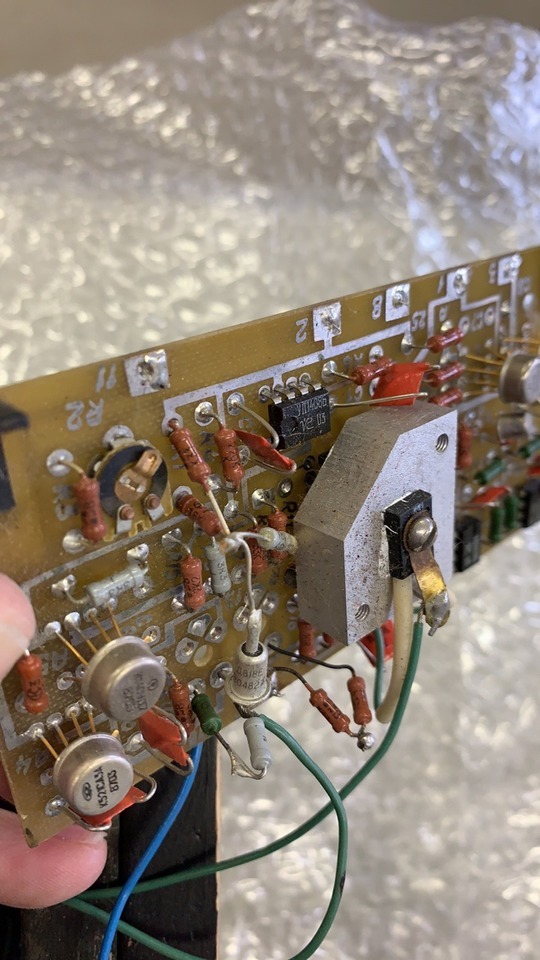

What the Jumping Fuck On A Stick is this Soviet Spaghetti here?!?! Flying resistors tied together with a goddam chunky diode thrown in for WHO THE FUCK KNOWS WHY!!??!? All I could do was shake my head. After some minutes of being rendered absolutely speechless had passed, I cleaned the menagerie of components up, just reflowing solder and nudging stuff closer to the board, really. But what the hell is up with this? Seriously if anyone out there has ideas, I am all ears!
I gave up on that board for the time being and then went about replacing all the switches that had their business ends broken off. Egor kindly supplied me with more than enough of the same type switches he got from Bog Knows Where. They all work now (mechanically anyway). The hardest thing was the Generator 1 Waveform Selector Assembly, as it has three switches that are mechanically interlinked, so when you press a new one down, the currently pressed down one will pop up—meaning only one selection can be made at a time. I uncovered the secrets of the inner workings of the assembly after desoldering the three switches and removing the whole shebang. I also discovered that the switch actuators themselves are different, as you can see below:
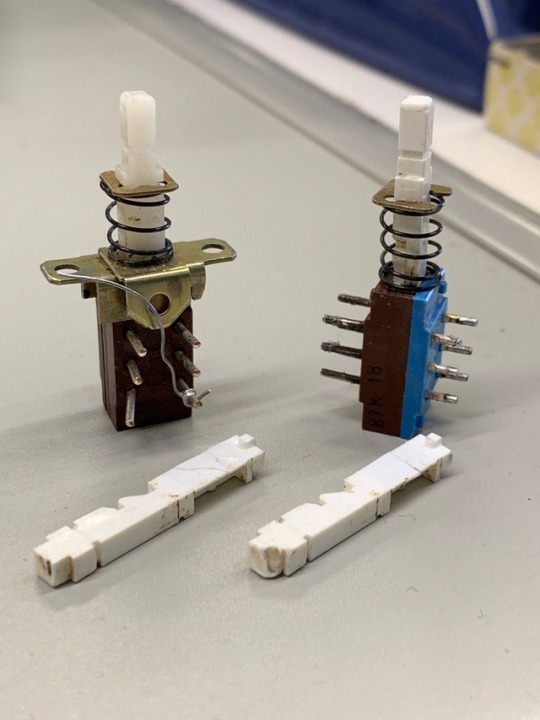
On the right, with bee-you-tee-full blue base, is an original switch from that assembly. On the left, a typical (standard?) switch. Same electrical connections and pinout (check out those legs! and on both sides too!!) so whatever. The actuators in front are broken ones from two of the three blue switches (I was letting them set after carefully superglueing them back together). See how they have little grooves in them? Those are there to slide a spring-loaded metal inner-faceplate along that then forces the other switches up when you press one down. Anyway, I swapped the blue ones out with the all-brown ones, so maybe if I get the Generator board working again, it’ll be possible to engage more than one waveform at a time. I’ve read reviews of this synth that say doing just that is possible, so I dunno what gives.
After some general cleaning and reflowing of sketchy looking solder, I was ready to plug it in to my step-up transformer and duck for cover. No explosions or smoke or arcs of unbridled electricity occured, thankfully. Oh I forgot to mention I replaced the 5-pin DIN main out with a standard 1/4” jack. Yeah. So I turned it on, the power LED came on, and the LFO LED lit up and cycled on and off properly, and the speed changed accordingly when I twiddled the speed knob so that was reassuring. But, no sound and no response from any key, period. I could make the LFO send the filter into near self-oscillation, but even that was super, super quiet. Nothing happened when I raised or lowered the Gen 1, Gen 2 or Noise knobs in the Mixer section. Oh well. Kind of a big let down. But I knew what I was in for when I started all this. In any case, I dunno where or how I’m gonna start troubleshooting this thing. OH and I found a loose wire too! One side is soldered to the switch in the LFO section that selects filter or Generator as the LFO’s destination. No idea where the other end belongs soldered up to. The schematics aren’t as easy to decipher as those of the Polivoks either, so there’s that to deal with too. In any case, I don’t expect I’ll have her up and running again all that soon. And as I said before, anyone out there with experience refurbing/resurrecting an Alisa 1387, feel free to chime in, as I’d really appreciate it!
To Be Continued.
4 notes
·
View notes
Text
#1 Wavetable oscillator as an LFO
I am deeply enamoured with low frequency oscillators -- this is no secret to anyone who has ever taken a course that I've taught or spoken to me about electronic music stuff for a little while. One of the things I find unsatisfactory about many commercial synthesizers and plugins is that they usually only have a few different choices for LFO shapes.

I understand that it's problematic to clutter an interface with too much complexity, but still, LFO's relate to rhythm in electronic music, so having such few options is a bit far from ideal, at least for the way that I like to work.
Using a wavetable oscillator as an LFO is a fantastic approach for creating interesting rhythms, whether it be pulsing, repetitive beats or frenetic bursts for aspiring breakcore musicians. I find that it's also useful to think about A-D-S-R type envelopes as building blocks for rhythms and phrases in electronic music... User interfaces often present an LFO or envelope as a mere effect or way of further shaping a sound, but there's a lot that they contribute to the way the musical material is developing.
Some commercial products like NI Massive and Absynth are pretty useful for using weird or complex wavetable shapes as LFO's, but tools like SuperCollider/Max/chucK allow you to achieve similar results, but also allow you to take advantage of the algorithmic capabilities of the language/environment.
side note about wavetables:
I've also been using wavetables and wavetable synthesis in a lot of my recent work. I like how wavetables, just a collection of points in a table, stored in a buffer, then used for an oscillator force you to think critically about how you're sculpting timbre in your work with sound. Even simple changes in the position or slope of a point in the table and you can drastically change the timbre of the oscillator that contains the wavetable.
Some simple/semi-simple SuperCollider examples demonstrating how to use a wavetable oscillator as an LFO to create interesting rhythms in a patch:
Very simple, just demonstration of the concept:

A more musical example, the right channel uses wavetable oscillators as LFO’s:
vimeo
https://drive.google.com/file/d/1MWNadRzY7AjWTXHBJVBPD5qrtmWvx_fT/view?usp=sharing
see google drive link for SuperCollider code.
0 notes
Text
Synths and The Empty Wallet e1
So, here we go. I've decided while I work on finalizing details on the album and send it off to mixing I would blog my dive into eurorack as well as some of my current synthy and hardware friends. Best way to begin is with
Why Eurorack?
Basically, it's going to play well with my existing patchable gear- which are the Korg MS-20 Mini, SQ-1, and Make Noise 0-coast. Right now, the MS-20 can be heard prominently throughout my album on at least 5 songs.

Here is a photo of that madness.
As well eurorack appears beginner friendly, in what I've seen, compared to other formats. It has drawbacks, but the sheer amount of modules available is staggering (for better or worse, but more on the worse later.)
Because of these reasons, I can essentially plan and configure a system that plays to what I have and allows me to explore neigh any sonic territory hardware synthesis and sampling has to offer. And holy shit, those Boomstar filters- but I digress.
The Concept
As it happens, I'm happy with my existing VCOs, especially as someone who loves FM the 0-coast covers that ground pretty nicely (though I will likely supplement with a sub oscillator/sine wave down the line.) I want to build a nice contained system that plays to the strengths of my existing gear while adding effects, opening ways to blend and route signals and explore more. I'm planning on making heavy use of the Korg's (and 0-coast) envelopes and lfos to modulate these potential effects, as well as being able to mult them to play into each other better.
The "affecter" is what I'm planning this system as. I'll also be using this to process external stuff as I explore and build sounds for The Alien Element. I have found, as well, working outside of software is so much more inspiring to me.
Lastly, plugins get outdated. They can't be resold. They don't hold value, and they won't always be supported. And yet, like plugins, a modular system can be combined any which way you want to accomplish amazing things. It's possible to open and troubleshoot hardware, to modify it, to trade it. Plugins? Not so much. Basically, I just really wanted to get outside the computer and stay there as long as I can, though The Alien Element never was and never will be a stranger to it.
Next update I'll cover from scratch building up the beginnings of my first system- case, modules, cables- and cover my choices, early sounds, and discoveries.
0 notes
Text
Dumpster Buffet
Do you ever find yourself faced with a large number of options, only to realize that each and every one of them is absolute garbage and in the end you're totally fucked no matter what? Pretty much sums up my feelings towards political goings on in the UN-United Snakes of A Merry Cow. Oh don't get me wrong, I'm all for whoever (whomever?) is going to rid the universe of the travesty to sentient life that is Conald J Drumpf and his entire crime family and entourage. But it all feels so fucking hopeless. Personally, I registered to vote by absentee ballot considering I live on the other side of the planet, but upon checking the relevant homepage to see where the fucking hell my goddam ballot is this late in the game, I see it was marked "mailed" on September 18th (that's a month and ten goddam days ago, people). In contrast, I have received things I've ordered off eBay and other US-based online shops, and none of those things took more than ten days—the last one took less than a week! Ah, this is how democracy dies. Yeah, a real dumpster buffet indeed. Fucking hell. Enough! On with the normal irregularly scheduled baloney!

It's Yamaha time! I dunno how I got interested in the VSS-30. Saw this one on the auction here, with this in the description, "Used to work, but I tried it recently and it wouldn't turn on." Checked eBay to see if they were still getting stupid money for these (they are). OK, let's bid 100 bucks and see what happens. $75 won it. Came in the original box, but no manual, oh well. Plugged it in to a spare Yamaha adapter I have and it worked no problem. Hmmmm. Maybe the dude was trying to run it on batteries? Opened it up and yikes the (-) spring terminal was corroded something fierce. Popped it out, slapped it in a shot glass filled with vinegar, and half an hour later it was clean. The wire broke off where it was soldered to the terminal while I had it soaking. Soldered it back together and everything is groovy now.

Other Yamaha happenings... I forget if I blabbed about this one but I don't think I did. I sold the TQ-5 I had here recently. Then a week later I saw a B200 for stupid cheap. The seller said the power button died so he wired up a rocker switch and installed that on the side where the output jacks are, and that otherwise, everything was fine. What the hell, why not? It's a lot more fun than the TQ was, but of course I feel that way about any keyboard versions of module synths. I was surprised how goddam LOUD the onboard speakers were too. Specs say 20W per channel and I don't think they're lying. Oof. It was one of the first in the EOS (Entertainment Operating System) line of synths. Evidently Tetsuya Komuro was a huge user/programmer/spokesperson for the EOS synths. I pretty much can't stand anything that fool has had his hands in, so it's virtually shocking that I actually bought this synth. But anyway, it works fine with a CTRLR editor for the TX81Z that you can download for free. You see, with the B200, like the YS200 and TQ5, the things you can actually edit from the front panel are SUPER limited, and I'm not shitting you about this, they've whittled the number of editable parameters down to like twenty or so, and the nomenclature is completely different to boot, so forget about programming patches from scratch with any of the synths in this family (I mean the YS100, YS200, B200 and TQ5, and I think there was another, DS55 or something?). If you have an editor, they will respond to sysex and you can change the algorithms and waveforms and all individual envelope settings and all that. If not, you get five categories of parameters: EG, TONE, LFO, NAME, EFFECT, and that's it. Under EG, you can alter the attack, decay and release of Tone, Volume, or both at the same time, but only by a factor of +/-10. Changes DO have an audible effect so that's nice. It's a bit weird. TONE lets you fool with Brilliance, Wave and Input-4Nos! (this lets you select the waveforms of the four operators but you'll have to hunt high and low before finding out exactly what those waveforms are). Brilliance seems to work like a basic filter or equalizer, with higher settings giving sharper, brighter sounds, and I feel like this is maybe tweaking the level of modulators to carriers? Wave wreaks havoc in a good way, and I'm not really sure what is going on here. Seems like Brilliance on steroids. LFO deals with the LFO. NAME... um, yeah, name. EFFECT lets you select which of the nine effects you want, or none, and just being able to slap a simple hall reverb on a pad sound makes a world of difference. I've sent TX81Z sysex to it and it worked fine. Combed through like 40 something banks I found online. Bought a memory card off eBay, and to my surprise it came loaded with compatible sounds! No idea what the previous owner used the card with but I am not complaining at all. I was gonna go and save the patches from those 40 banks that I thought were interesting, but again, surprise surprise! Most of those sounds were already there. WEIRD!!! Anyway, it's easy to take a preset sound that is somewhat in the neighborhood of a sound you have in mind and then tweak the few parameters that you can from the front panel, and get interesting results doing so. But, even though the CTRLR editor does the job, and you get total programmability, it doesn't make much sense unless you're super familiar with how FM works, and I am far from it, so I dunno how I feel about it altogether. Neat synth in any case. I'd like to get the iPad editor and the TQ5 panel, but my iPad is ancient so unless I'm going to shell out a few hundred bucks for a newer iPad.... well... Hmmmm.

Stolen from the internet, this photo. Heh. Weird synth. Fun anyway.

The last item in my series of Yamaha stuff is the DR100 Digital Reverb, a half-rack weirdo reverb processor. I've had other things in this same line of half-rack effectors from Yamaha before (a super freaky guitar processor loved by a certain Legowelt, just for one). They're all pretty much well into oddball territory and this reverb is no exception. It's a very slimmed down processor, with only four preset reverbs to choose from, but it has a 3-band EQ as well as a mix knob, so that livens things up a bit. crank the knobs for some super what-the-hell-are-you-thinking settings! I have the VSS-30 run through it at the moment, and it adds to the fun, let me tell ya. And at this point, I need all the fun I can get! That's all for now, my invisible internet pals.
0 notes
Text
July 16, 2020 at 10:03PM - BEAT ZAMPLER Workstation Plus 3 Studio Pack (100% discount) Ashraf
BEAT ZAMPLER Workstation Plus 3 Studio Pack (100% discount) Hurry Offer Only Last For HoursSometime. Don't ever forget to share this post on Your Social media to be the first to tell your firends. This is not a fake stuff its real.
Audio Workstation for VST&AU + 4 GB Soundbanks
BEAT ZAMPLER is a workstation that includes a variety of ways to sculpt and manipulate sounds and it includes features you would expect in any current soft-sampler. It also sounds great!
Features
The plug-in comes in both VST and AU formats. File types supported are REX loop and SFZ.
The plugin’s sample oscillators make Zampler a great tone-shaping tool
In the integrated multimode, lowpass, highpass, bandpass and bandstop filters, as well as various combinations are available
Three LFOs, three ADSR envelopes and a complex modulation matrix, bring life to the sound.
An extensive effects section is available including tube saturation, two equalizers, phaser, chorus, delay and reverb.
The clever step sequencer allows for especially complex, full and vibrant sounds – a speciality of Zampler.
Uses the valent algorithms of “Dune” inventor Synapse Audio
More Details:
Samples of any bit-depth (8/16/24/32-bit), mono or stereo are supported
Multiple sample rates supported (eg 44.1k, 48k, 88.2k, 96k, 176.4k, 192k, 384k)
Up to 128 keyboard splits
Up to 128 velocity splits
Soundbanks on Top
Ethnic Pads: 32 patches
This collection excels in atmospheric sounds in a broader sense, comprising bells, choirs, cymbals, flutes, chimes or strings and much more. We pushed the sounds to their limit and injected a heavy dose of electro to give the sounds enough bite to cut through modern EDM productions. With our Zampler workstation featuring flexible filter and modulation options, you can easily create unexpected sound textures from the sample material.
ROBO#tTXTR – vocal Soundbank. 34 patches + 40 loops
Robo #txtr“ is an extensive collection with 1.5 GB of electronic vocals, phrases, machine and robot noises. Expect production-ready presets, just waiting to be manipulated with its flexible sound editing and automation tools.
SUPREME EDM The best analogue synthesizers – 32 patches + 32 loops
Modesty is not this packs’ strength – „Supreme“ combines sounds of the best analog synthesizers of all time. With 32 brutal patches and 32 loops you are perfectly prepared for future Dubstep, D&B and EDM adventures. The editorial staff of Beat presents 620 MB of its favorite bass and lead sounds, which give your tracks a special touch and a high recognition value.
Brute Factor: 760 MB Leads & Bonus-Tracks
Analog sound is always wanted. And it’s even more wanted when it sounds fat or brute. Just like the Arturia MiniBrute 2. As the synth was already honored with full marks, we just made a studio session and dressed it up for our very own Zampler, so you can now enjoy the savage sounds yourself. And we included a bonus, something that the MiniBrute hardware can’t do: Pads. Happy blasting!
MANTRA PADS – 33 relaxing patches – 1,6 GB Power
The power of repetition! With their lush character most pads have an instant relaxing impact. Our latest Zampler sound bank takes this a step further and combines pleasing pads with ever-repeating mantras, to maximize the hypnosis-factor. 33 patches of pure deceleration.
PROPHET-12: 78 patches 2 GB analogue masterpieces
So many famous artists using the Prophet-12 can’t be wrong: Dave Smith’s luxury synth is a true multi-talent when it comes to sound design. From underground clubs to airplay charts, its fat basses, leads and pads fit everywhere. So here you go with your own Pro-12 for Zampler//RX!
TORAIZ AS-1 – 64 patches + 64 loops: 734 MB Beat, Leads, Pads & loops
Thanks to his Prophet-6 core, the new Toraiz AS-1 is born to be an iconic legend. We created 128 patches and sequences of that little muscleman, ready to play for your Zampler. Enjoy!
from Active Sales – SharewareOnSale https://ift.tt/392928U https://ift.tt/2CDdU8h via Blogger https://ift.tt/3jcrEYt #blogger #bloggingtips #bloggerlife #bloggersgetsocial #ontheblog #writersofinstagram #writingprompt #instapoetry #writerscommunity #writersofig #writersblock #writerlife #writtenword #instawriters #spilledink #wordgasm #creativewriting #poetsofinstagram #blackoutpoetry #poetsofig
0 notes